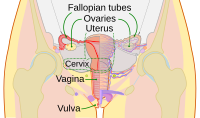Vagina: Part of the female genital tract
The vagina is a part of the female body.
It is between the perineum and the urethra. The vaginal opening is much larger than the urethral opening. It is a tube leading from the uterus to the outside of the body. Menstrual fluid (red, blood-filled liquid lost during menstruation) leaves the body through the vagina. During sexual intercourse, the penis is put into the vagina. During birth, the vagina opens to let the baby come out from the uterus. The vagina is reddish-pink in color, though colors may vary.
| Vagina | |
|---|---|
 Diagram of the female human reproductive tract and ovaries | |
 Vulva with pubic hair removed and labia spread to show the opening of the vagina:
| |
| Details | |
| Precursor | urogenital sinus and paramesonephric ducts |
| Artery | superior part to uterine artery, middle and inferior parts to vaginal artery |
| Vein | uterovaginal venous plexus, vaginal vein |
| Nerve |
|
| Lymph | upper part to internal iliac lymph nodes, lower part to superficial inguinal lymph nodes |
| Identifiers | |
| Latin | Vagina |
| MeSH | D014621 |
| TA | A09.1.04.001 |
| FMA | 19949 |
| Anatomical terminology | |
Development
Between the ages of 9-15 years, the vagina and uterus get bigger. The uterus is the organ in which a baby grows. The external opening of the vagina leading to the vulva, between the legs. A clear or whitish fluid may start to flow out of the vagina to keep it clean.
Location
The opening to the vagina is located behind the urethral opening and in front of the perineum. The vagina is the tube leading from the uterus to the outside of the body. The opening is between the legs, inside the labium, behind the opening to the urethra, and in front of the anus.
Anatomy
The vagina is an elastic, muscular tube. It starts at the cervix and ends at the vulva. It is about 6 to 7.5 centimetres (2.4 to 3.0 in) wide, and 9 centimetres (3.5 in) long. During sexual intercourse and childbirth, the vagina gets wider and bigger. It has to be lubricated to stay clean and allow sexual intercourse and childbirth. It is lubricated partially by the Bartholin's glands. This lubrication also allows sperm easier access to fertilize an ovum.
The vaginal biome

Like many tissues, the vagina has a natural biome, a flora and fauna of microscopic organisms. The vagina is an interface between the host and the environment. Its surface is covered by a protective epithelium where bacteria and other microorganisms grow. The ectocervix (that's the vaginal part of the cervix) is not sterile.
Functions
Release
The vagina releases blood and tissue during menstruation. Tampons or other products can be used to absorb some of the blood.
Sexual activity
When a woman is aroused, she has pleasurable feelings in her genital region. The vagina gets up to 8.5 centimetres (3.3 in) wide. It can get bigger with more stimulation. During sexual intercourse, the man's penis is placed in the woman's vagina. The vagina is warm and soft, and it places pressure on the man's penis. That can feel good for both partners and usually makes the man have an orgasm after repeated thrusts. For orgasm in women, the vagina has significantly fewer nerve endings than the clitoris, and therefore rubbing or applying other consistent pressure against the clitoris is usually needed to help the woman have an orgasm. During the man's orgasm, he ejaculates semen from his penis into the vagina. The semen contains sperm. The sperm can move from the vagina into the uterus to fertilize an egg and make a woman pregnant.
The G-spot may be a highly sensitive area near the entrance inside of the human vagina. If stimulated, it leads to a strong orgasm or female ejaculation in some women. Some doctors and researchers who specialize in the anatomy of women believe that the G-spot does not exist, and that if it does exist, it is an extension of the clitoris.
Childbirth
During birth, the vagina acts as a pathway for the baby to leave the mother's body. The vagina is very elastic and stretches to many times its normal diameter during birth.
Pregnancy
Sperm needs to be deposited at the top of the vagina near the cervix and fertilize the ovum (egg) if pregnancy is to occur. In a normal childbirth, babies come out through the vagina.
Related pages
References
Other websites

- Pink Parts Archived 2008-10-22 at the Wayback Machine - More information on female sexual anatomy.
This article uses material from the Wikipedia Simple English article Vagina, which is released under the Creative Commons Attribution-ShareAlike 3.0 license ("CC BY-SA 3.0"); additional terms may apply (view authors). Content is available under CC BY-SA 4.0 unless otherwise noted. Images, videos and audio are available under their respective licenses.
®Wikipedia is a registered trademark of the Wiki Foundation, Inc. Wiki Simple English (DUHOCTRUNGQUOC.VN) is an independent company and has no affiliation with Wiki Foundation.